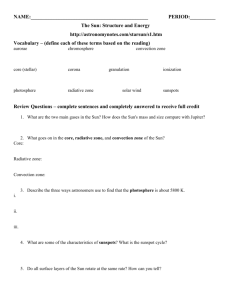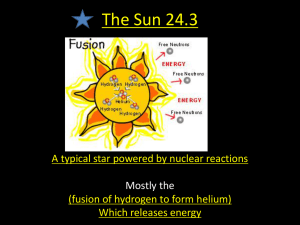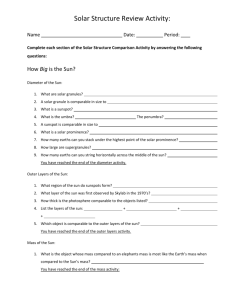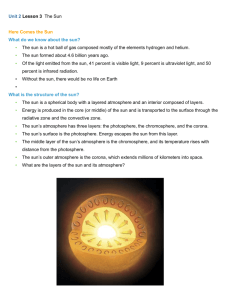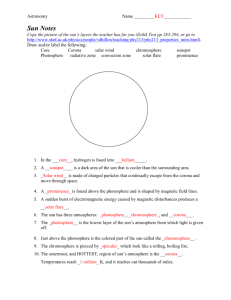It is evident from our observations of impact craters on planets and
advertisement
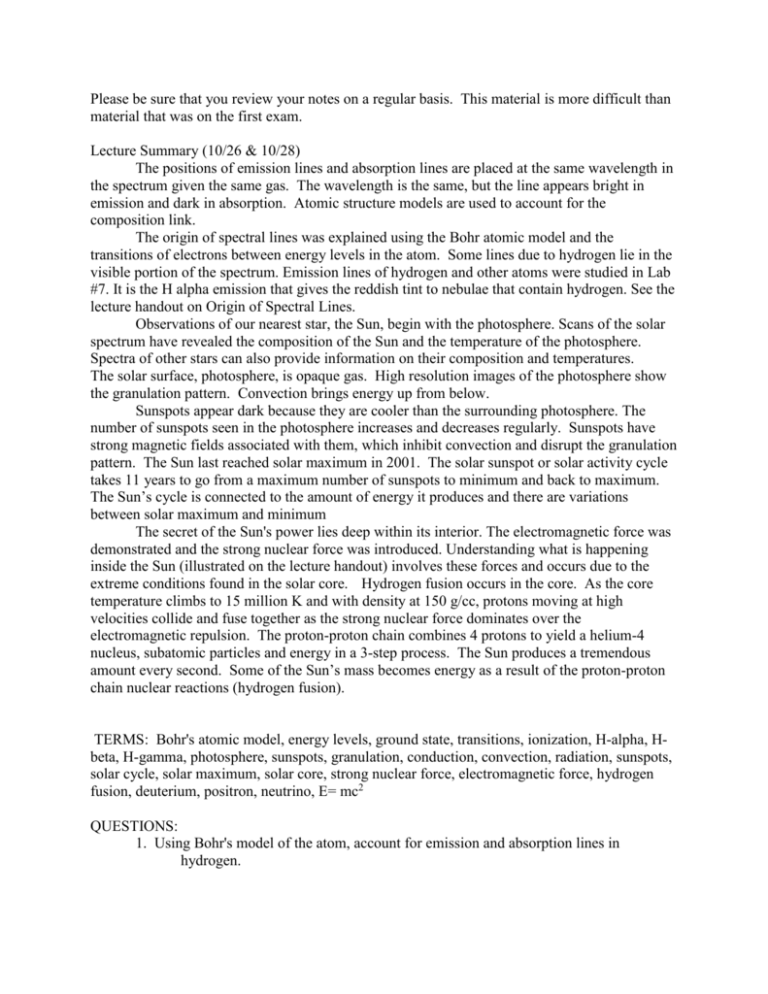
Please be sure that you review your notes on a regular basis. This material is more difficult than material that was on the first exam. Lecture Summary (10/26 & 10/28) The positions of emission lines and absorption lines are placed at the same wavelength in the spectrum given the same gas. The wavelength is the same, but the line appears bright in emission and dark in absorption. Atomic structure models are used to account for the composition link. The origin of spectral lines was explained using the Bohr atomic model and the transitions of electrons between energy levels in the atom. Some lines due to hydrogen lie in the visible portion of the spectrum. Emission lines of hydrogen and other atoms were studied in Lab #7. It is the H alpha emission that gives the reddish tint to nebulae that contain hydrogen. See the lecture handout on Origin of Spectral Lines. Observations of our nearest star, the Sun, begin with the photosphere. Scans of the solar spectrum have revealed the composition of the Sun and the temperature of the photosphere. Spectra of other stars can also provide information on their composition and temperatures. The solar surface, photosphere, is opaque gas. High resolution images of the photosphere show the granulation pattern. Convection brings energy up from below. Sunspots appear dark because they are cooler than the surrounding photosphere. The number of sunspots seen in the photosphere increases and decreases regularly. Sunspots have strong magnetic fields associated with them, which inhibit convection and disrupt the granulation pattern. The Sun last reached solar maximum in 2001. The solar sunspot or solar activity cycle takes 11 years to go from a maximum number of sunspots to minimum and back to maximum. The Sun’s cycle is connected to the amount of energy it produces and there are variations between solar maximum and minimum The secret of the Sun's power lies deep within its interior. The electromagnetic force was demonstrated and the strong nuclear force was introduced. Understanding what is happening inside the Sun (illustrated on the lecture handout) involves these forces and occurs due to the extreme conditions found in the solar core. Hydrogen fusion occurs in the core. As the core temperature climbs to 15 million K and with density at 150 g/cc, protons moving at high velocities collide and fuse together as the strong nuclear force dominates over the electromagnetic repulsion. The proton-proton chain combines 4 protons to yield a helium-4 nucleus, subatomic particles and energy in a 3-step process. The Sun produces a tremendous amount every second. Some of the Sun’s mass becomes energy as a result of the proton-proton chain nuclear reactions (hydrogen fusion). TERMS: Bohr's atomic model, energy levels, ground state, transitions, ionization, H-alpha, Hbeta, H-gamma, photosphere, sunspots, granulation, conduction, convection, radiation, sunspots, solar cycle, solar maximum, solar core, strong nuclear force, electromagnetic force, hydrogen fusion, deuterium, positron, neutrino, E= mc2 QUESTIONS: 1. Using Bohr's model of the atom, account for emission and absorption lines in hydrogen. 2. Explain why absorption lines and emission lines for an element like hydrogen always occur at the same wavelength positions. 3 How do astronomers explain the changing granulation pattern (from hour to hour) of the photosphere? 4. Explain why the Sun cools in a region in which a sunspot forms. 5. Describe the conditions inside the Sun (from photosphere to solar core). 6. Why does the Sun shine? 7. Explain why fusion occurs only in the solar core. 8. Explain in words what happens during the proton-proton chain (hydrogen fusion in the Sun). 9. How are temperature and composition determined from stellar spectra?

